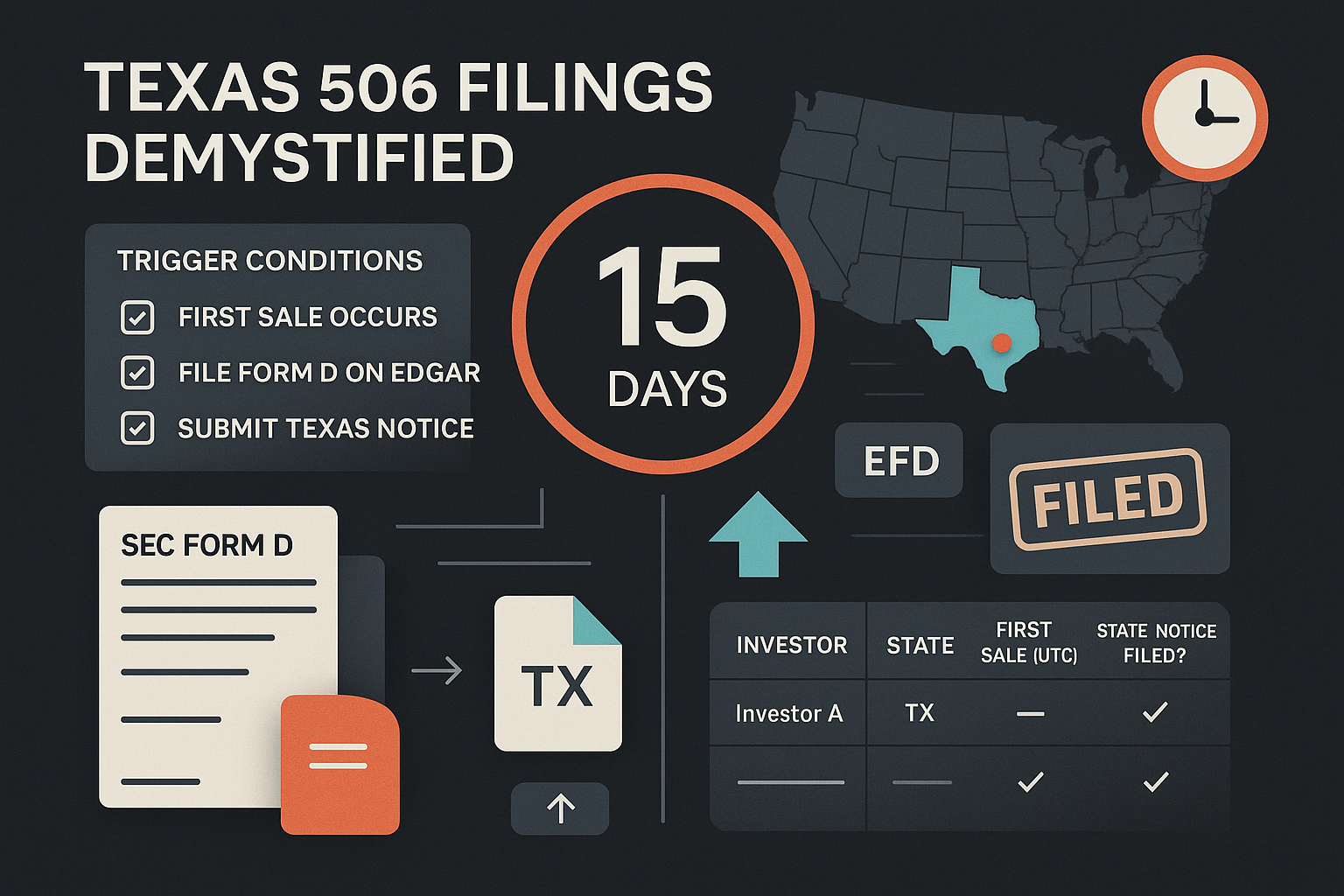Texas Rule 506 Notice Filings: Exact Steps, Timing, and Checklists

Loading the Elevenlabs Text to Speech AudioNative Player...
Scope: This guide assumes you’re raising under Rule 506(b) or Rule 506(c) and have (or expect) Texas purchasers.
What triggers a Texas notice—and when
- Federal trigger: File SEC Form D within 15 calendar days after the first sale.
- Texas trigger: When you sell to a Texas resident in a Rule 506 offering, Texas requires a state notice. Texas keys timing to the first sale of securities in Texas.
- If the due date lands on a weekend/holiday, file by the next business day.
- Always confirm current procedures/fees on the TSSB site; do not hardcode dollar amounts.
Define “first sale”: The date/time your company becomes irrevocably committed with a purchaser (e.g., countersigned subscription + funds, or other binding commitment).
What you submit (Texas)
- Copy of the SEC Form D you filed with the SEC
- Issuer and contact details (captured in EFD workflow)
- Any Texas‑specific attestations requested in EFD
- Payment of the Texas notice fee per current TSSB schedule (verify before paying)
How you submit (process)
- File Form D on EDGAR within 15 days of the first sale.
- Log into NASAA’s EFD and select Texas for your Rule 506 notice.
- Upload/confirm required items and pay the applicable fee.
- Save submission receipts and payment confirmations with your offering records.
Where to file:
- EFD: https://www.efdnasaa.org
- TSSB (rules, fees, and instructions): https://www.ssb.texas.gov
Amendments & follow‑ups
- Amend Texas contemporaneously with any SEC Form D amendment (e.g., material changes, corrections).
- If details change in a way that affects fee calculations or disclosure, follow TSSB guidance (including “excess sales” scenarios).
- Keep your state matrix current (who bought, where they reside, first‑sale dates, filing confirmations).
Texas Rule 506 Notice — Master Checklist
A) Before the first offer
- Choose your exemption: 506(b) (no general solicitation) vs 506(c) (general solicitation + verification).
- Tighten your documents: subscription, investor questionnaire, cap table summary, financials, tailored risk factors.
- Plan communications:
- 506(b): private, relationship‑based outreach only.
- 506(c): public messaging allowed; set up accredited‑status verification workflow (third‑party letters or documentation).
- Create a state‑by‑state tracker: investor name, state, first‑sale date, notice status, confirmation number.
B) Day 0 — First sale occurs
- Record the exact date/time of the first binding commitment.
- Update the tracker with purchaser state and sale date (note Texas vs. other states).
C) Within 15 calendar days after the first sale
- File SEC Form D (EDGAR).
- File the Texas Rule 506 notice via EFD if any purchaser is a Texas resident; pay the fee (verify current amount).
- Calendar/file notices for other purchaser states as required (many accept EFD).
- Save receipts and payment confirmations.
D) During the raise (rolling closes)
- Maintain disclosure integrity (update changes promptly).
- Track accreditation:
- 506(b): keep signed questionnaires/notes.
- 506(c): take and document reasonable steps to verify (self‑certification is not enough).
- Messaging guardrails:
- 506(b): avoid general solicitation.
- 506(c): ensure public statements match disclosures; Texas anti‑fraud applies.
- Each time a Texas purchaser invests, confirm that a Texas notice is on file (amend if details have materially changed).
E) After closing
- Consider whether a Form D amendment is needed (e.g., to correct errors or reflect material changes).
- If you amend federally, amend Texas via EFD as applicable.
- Retain records: executed subs, questionnaires, 506(c) verification files, notices, receipts, board approvals, comms logs.
State Matrix (template)
| Investor | State | First Sale (UTC) | SEC Form D Filed? | State Notice Filed? | Confirmation # | Notes |
|---|---|---|---|---|---|---|
| Investor A | TX | YYYY‑MM‑DD hh:mm | ✅ | ✅ | TX‑EFD‑##### | 506(c) verified on YYYY‑MM‑DD |
| Investor B | CA | YYYY‑MM‑DD hh:mm | ✅ | ✅ | CA‑EFD‑##### | … |
Pro tips (hard‑won details)
- Assign a single owner for all filings.
- Start a countdown from Day 0; avoid last‑minute EDGAR/EFD hiccups.
- If your round will likely include Texas investors later, set a reminder to file as soon as the first Texas sale posts.
- Do not hardcode fees; verify on TSSB before paying.
Filing FAQs (Texas + Rule 506)
Do I need a Texas filing if I used 506(b) or 506(c) and sold to a Texas resident?
Yes. NSMIA preempts registration, not state notice + fees + anti‑fraud.
What if I started private (506(b)) and then went public (506(c))?
Manage sequencing carefully and see integration rules (Rule 152). Keep funnels separate and document timing.
Where do I actually file?
EFD for Texas (https://www.efdnasaa.org). Confirm process/fees on TSSB (https://www.ssb.texas.gov).
References & Sources
- NASAA EFD: https://www.efdnasaa.org
- Texas State Securities Board (TSSB): https://www.ssb.texas.gov
- Reg D (17 CFR Part 230): https://www.ecfr.gov/current/title-17/chapter-II/part-230
- Rule 152 (integration): https://www.ecfr.gov/current/title-17/section-230.152
Feedback & Corrections
See our Corrections Policy and email [email protected] with updates or suggestions.
Disclaimer
Informational only; not legal advice. Rules, forms, and fees change—verify current Texas requirements with the TSSB before filing.

